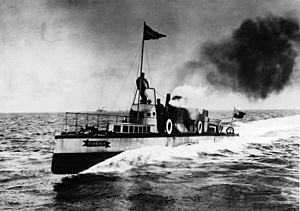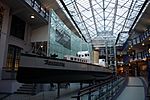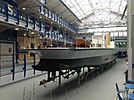Turbinia facts for kids

Turbinia at speed in 1897
|
|
Quick facts for kids History |
|
|---|---|
| Name | Turbinia |
| Launched | 2 August 1894 |
| Out of service | 1927 |
| Refit | 1960s |
| Nickname(s) | "The Ocean Greyhound" |
| Status | Museum ship |
| General characteristics | |
| Displacement | 44.5 long tons (45.2 t) |
| Length | 104 ft 9 in (31.93 m) |
| Beam | 9 ft (2.7 m) |
| Draught | 3 ft (0.91 m) |
| Installed power |
|
| Propulsion |
|
| Speed | 34.5 knots (63.9 km/h; 39.7 mph) |
The Turbinia was the very first steamship to be powered by a steam turbine. Built in 1894, this experimental ship was the fastest in the world at that time. It made a huge impression at the Spithead Navy Review in 1897. The Turbinia showed everyone how future steamships would be built, with most of them using turbine power. Today, you can see the Turbinia at the Discovery Museum in Newcastle upon Tyne, North East England. Its original engine is kept at the Science Museum in London.
Contents
How the Turbinia Was Developed
Charles Algernon Parsons invented the modern steam turbine in 1884. He quickly realized that this new engine could make ships much faster. So, in 1897, he started his own company, the Parsons Marine Steam Turbine Company. To test his ideas, he had the experimental ship Turbinia built. It was made of light steel by a company called Brown and Hood in Wallsend on Tyne.
The British Admiralty (the people in charge of the British Navy) watched the project closely. The Turbinia was launched on August 2, 1894. At first, the trials with just one propeller were not very good. Parsons then discovered a problem called cavitation. This happens when propellers spin so fast that they create bubbles in the water, which makes them less effective.
To fix this, Parsons built the first cavitation tunnel to study the problem. His research led him to put three turbines on three separate shafts. Each shaft then drove three propellers, meaning the ship had a total of nine propellers! With this new setup, the Turbinia reached an amazing speed of over 34 knots (63 km/h; 39 mph). People were convinced that Turbinia was a true "North Sea greyhound" – a very fast ship.
An Amazing Demonstration
Parsons decided to show off his incredible ship at the Navy Review for Queen Victoria's Diamond Jubilee. This big event took place at Spithead on June 26, 1897. Many important people were there, including the Prince of Wales and foreign leaders. Without being invited, the Turbinia suddenly appeared. It was much faster than any other ship there.
In a bold move, the Turbinia raced between the lines of navy ships. It zoomed up and down in front of the crowd and princes. A navy patrol boat tried to catch it, but the Turbinia easily got away, almost swamping the smaller boat with its powerful wake. This was a huge publicity stunt!
A photographer named Alfred J. West took many pictures of the Turbinia speeding along. Sir Charles Parsons later invited him to film and photograph the ship on the River Tyne and in the nearby North Sea. These pictures are still the most famous images of the Turbinia in action.
After this clear show of speed and power, the Admiralty was very impressed. Parsons then set up the Turbinia Works in Wallsend. This factory built the engines for two new turbine-powered destroyers for the Navy: HMS Viper and HMS Cobra. Both ships were launched in 1899. Sadly, both were lost in accidents in 1901. Even though these losses slowed things down, the Navy was still convinced that turbines were the future. In 1900, the Turbinia even traveled to Paris to be shown to French officials and displayed at the Paris Exhibition.
The first merchant ship (a ship that carries goods or passengers) to use turbine power was the TS King Edward in 1901. By 1905, the Admiralty decided that all new Royal Navy ships would use turbine engines. In 1906, the first turbine-powered battleship, the amazing HMS Dreadnought, was launched.
The Crosby Incident
On January 11, 1907, the Turbinia was involved in an accident. It was hit by another ship called the Crosby. The Crosby was being launched across the River Tyne from the south bank. The collision nearly cut the Turbinia in half!
Luckily, the Turbinia was repaired. It even steamed alongside the RMS Mauretania (which was also turbine-powered) after the launch of that huge ocean liner. However, the Turbinia had some mechanical problems and could not go with the Mauretania all the way down the River Tyne to the sea.
Turbinia as a Museum Ship
To stop the Turbinia from getting worse, the company decided to lift it out of the water in 1908. In 1926, the directors of the Parsons Marine Steam Turbine Company offered the ship to the Science Museum, London. The Turbinia was too big to fit in the museum, so it was cut into two halves. The back part, with its engines and propellers, was put on display in London.
The front part of the ship was given to Newcastle in 1944. It was displayed in the city's Exhibition Park. In 1959, the Science Museum took the back part of the Turbinia off display. By 1961, a new middle section was built, and the Turbinia was put back together. It was then displayed in the Newcastle Municipal Museum of Science and Industry. A full reconstruction of the ship happened in 1983.
On October 30, 1994, exactly 100 years after its launch, the Turbinia was moved to Newcastle's Museum of Science and Engineering. This museum was later renamed the Discovery Museum. The ship went on public display there in March 1996. The Turbinia is listed as part of the National Historic Fleet. In 2000, it was the main focus of a big £10.7 million project to improve the Discovery Museum. The area around the Turbinia was the first part to be updated. This involved raising the roof by one floor to create viewing areas on three different levels.
See also
 In Spanish: Turbinia para niños
In Spanish: Turbinia para niños




